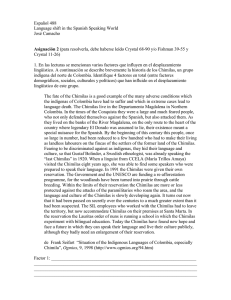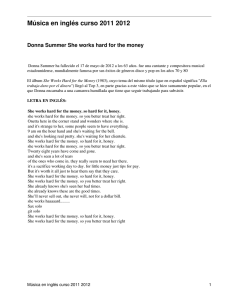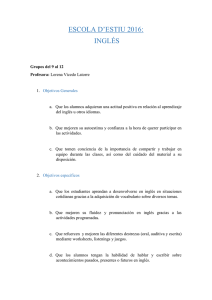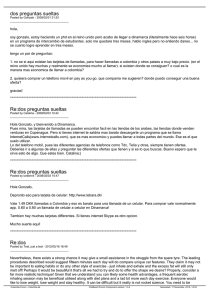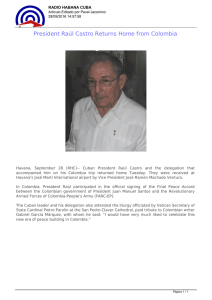English - SciELO Colombia
Anuncio
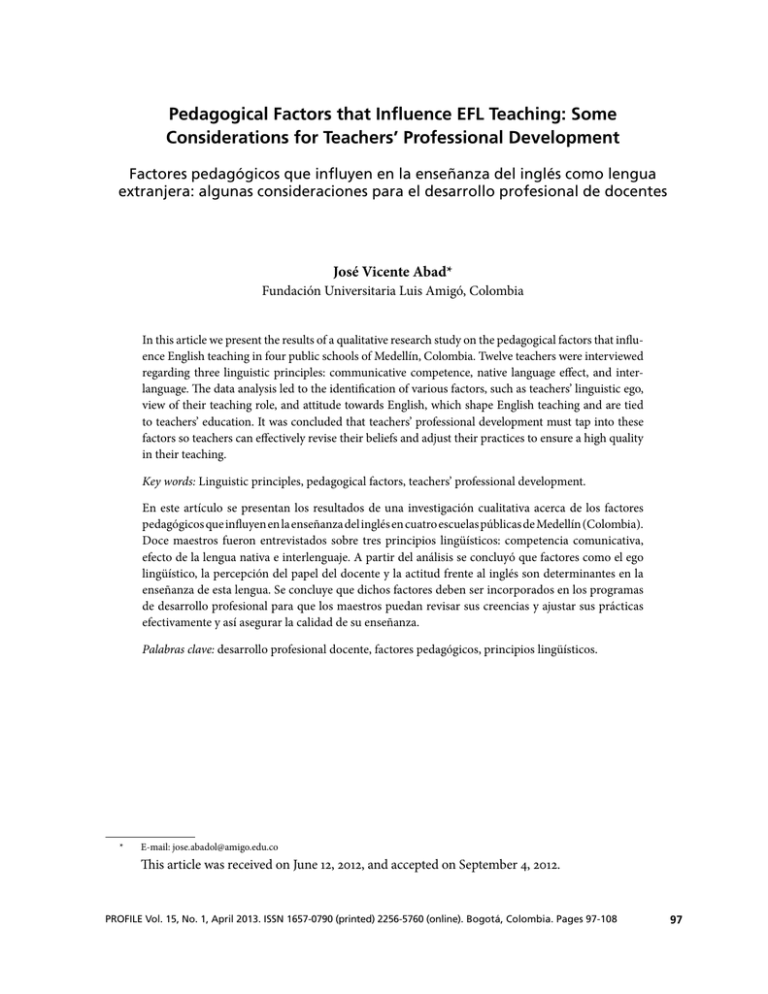
Pedagogical Factors that Influence EFL Teaching: Some Considerations for Teachers’ Professional Development Factores pedagógicos que influyen en la enseñanza del inglés como lengua extranjera: algunas consideraciones para el desarrollo profesional de docentes José Vicente Abad* Fundación Universitaria Luis Amigó, Colombia In this article we present the results of a qualitative research study on the pedagogical factors that influence English teaching in four public schools of Medellín, Colombia. Twelve teachers were interviewed regarding three linguistic principles: communicative competence, native language effect, and interlanguage. The data analysis led to the identification of various factors, such as teachers’ linguistic ego, view of their teaching role, and attitude towards English, which shape English teaching and are tied to teachers’ education. It was concluded that teachers’ professional development must tap into these factors so teachers can effectively revise their beliefs and adjust their practices to ensure a high quality in their teaching. Key words: Linguistic principles, pedagogical factors, teachers’ professional development. En este artículo se presentan los resultados de una investigación cualitativa acerca de los factores pedagógicos que influyen en la enseñanza del inglés en cuatro escuelas públicas de Medellín (Colombia). Doce maestros fueron entrevistados sobre tres principios lingüísticos: competencia comunicativa, efecto de la lengua nativa e interlenguaje. A partir del análisis se concluyó que factores como el ego lingüístico, la percepción del papel del docente y la actitud frente al inglés son determinantes en la enseñanza de esta lengua. Se concluye que dichos factores deben ser incorporados en los programas de desarrollo profesional para que los maestros puedan revisar sus creencias y ajustar sus prácticas efectivamente y así asegurar la calidad de su enseñanza. Palabras clave: desarrollo profesional docente, factores pedagógicos, principios lingüísticos. * E-mail: jose.abadol@amigo.edu.co This article was received on June 12, 2012, and accepted on September 4, 2012. PROFILE Vol. 15, No. 1, April 2013. ISSN 1657-0790 (printed) 2256-5760 (online). Bogotá, Colombia. Pages 97-108 97 Abad Introduction An unprecedented educational reform in the field of language teaching and learning is well on its way in Colombia since the Ministry of Education presented the National Bilingual Program (NBP) for the period 2004 – 2019, and whose most-cited publication to date has been the Basic Standards for Foreign Language: English (Ministerio de Educación Nacional – MEN, 2006). The plan seeks for Colombian citizens to become bilingual in English and Spanish to strengthen the country’s position in the arena of global politics and transnational markets. Although stakeholders at the academic, political, and financial levels agree on the need for a policy to guide the dissemination of foreign languages within the national territory, the program has not been free from criticism. On the one hand, some researchers (De Mejía, 2006; Usma, 2009) have warned that the plan, based on imported policies and adopted without any consideration of the local culture and knowledge, could easily contribute to widen the social gap between cultural minorities, underprivileged citizens, and elite economic groups. By demanding the same results from all Colombian students without making any provisions for their social background, the plan accentuates the disparities between private and public education, and thus perpetuates existing conditions of inequality. On the other hand, the conditions to properly implement foreign language teaching and learning in Colombian public schools are not given. Some researchers (Cadavid, McNulty, & Quinchía, 2004; Valencia, 2006 as cited by Usma, 2009) had already made this point back in times of the General Education Law (Ley General de Educación, 1994). Paradoxically, although some changes have been made in the public sector, they are not enough to meet the ambitious goals set by the NBP1. This imbalance 1 According to the Program, by the year 2019 all high school students should graduate with an English level of B1, and all English teachers should have an English level of C1 according to the Common European Framework of Reference (Council of Europe, 2001). 98 has once again brought to the forefront the impending need for a structural revamp of the public educational system, which appears to be humanly and logistically unprepared to measure up to the challenge presented by the current policy. Teachers’ Professional Development In fact, when political and educational authorities consider the implementation of the program, the first question they must answer is how to prepare teachers for the task. The professional development of English teachers (TPD) in Colombia, its challenges, and its implications have been in the center of academic discussion in recent years (Cadavid, Quinchía & Díaz, 2009; Cárdenas, González & Álvarez, 2010). In theory, TPD emerges from a genuine commitment between teachers and the academic, professional, and social communities they serve; it involves an intentional, systematic, and continuous process by which teachers further their personal, professional and political growth; and it entails the improvement of teachers’ attitudes, skills, and knowledge with regard to their practice. Unfortunately, this is rarely the case in Colombia. In this climate of concern as to the implementation of the plan and its impact on the public school system, particularly as concerns the professional development of teachers, an interdisciplinary group of researchers in the areas of psychology and English teaching at Fundación Universitaria Luis Amigó conducted a mixed research study about the psycholinguistic and the pedagogical factors that influence the teaching and learning of English as a Foreign Language in four public schools in Medellín, Colombia. Following a quantitative approach, psychologists examined the psycholinguistic factors that either facilitate or encumber the learning of English as a foreign language in students ages nine through 12. With these psycholinguistic competences in mind, English teachers-researchers followed a qualitative approach to determine the pedagogical factors that Universidad Nacional de Colombia, Facultad de Ciencias Humanas, Departamento de Lenguas Extranjeras Pedagogical Factors that Influence EFL Teaching: Some Considerations... influence the teaching of English at the participating schools. To that end we chose the three linguistic principles of language teaching according to Brown (2007) i.e. communicative competence, interlanguage, and native language effect, as a starting point to discuss with teachers their perception of English teaching and learning in their classrooms. After the analysis, some unforeseen data emerged. We grouped them into three general categories: internal and external pedagogical factors, teaching and learning strategies, and teachers’ professional development. This article summarizes the results of the study’s qualitative component, and particularly focuses on the internal pedagogical factors and on the way they are linked to teachers’ professional development. At the end, in light of the demands posed by the NBP, a case is made for the inclusion of such factors in TPD programs so teachers can revise their beliefs and adjust their practices to ensure a high quality in their teaching. Literature Review Pre-established Categories The communicative competence is a comprehensive construct that encompasses all the necessary skills to communicate effectively through the use of verbal and non-verbal language (Canale & Swain, 1980; Bachman & Palmer, 1996). According to Bachman and Palmer (1996), language ability is divided into organizational knowledge and pragmatic knowledge. Organizational knowledge comprises grammatical knowledge, required to operate at the word and sentence levels, and textual knowledge, which deals with the more complex aspect of text. Pragmatic knowledge comprises functional knowledge, which accounts for the ability to communicate and interpret intentions; and sociolinguistic knowledge, which allows language users to effectively communicate within a socio-cultural context. In addition to these types of knowledge, the communicative competence also includes strategic competence and psychomotor skills. In the process of developing their communicative competence, learners move through a rather systematic process of reconstruction of the language of study. Interlanguage is the scientific term used to describe the learners’ interim system of hypotheses about the structure and functioning of the target language that learners build up in their mind as they progress toward communicating with an ever closer-to-standard version of it (White, 2003; Brown, 2007). The learners’ successful passage through these interlinguistic stages largely depends on the teachers’ instruction and feedback, a process that can be interpreted as a language-learning version of Vygotsky’s Zone of Proximal Development (Vygotsky, 1978). Learners’ native language greatly influences the development of their communicative competence in a foreign language, as it largely shapes their interlanguage, particularly in its initial stages. This influence is known as the native language effect. According to Brown (2007), although the native language both facilitates and interferes with the learning of other languages, the interfering aspect of it is often more easily perceived in class. Emerging Categories By factors we refer to the conditioning forces that regulate the relations among the constituent elements of the teaching and learning process i.e. teachers, students, methodology, and subject matter (Abad & Maturana, 2010). Internal factors are subjective and relational; they originate in the individuals and shape their classroom roles and relationships. Some of them are students’ and teachers’ perceptions, beliefs and attitudes. In a recent study, López (2010) established that: (…) teachers’ perceptions are reflected in their attitudes. To be exact, one’s attitudes toward an innovation are the result of the perceptions (and quite possibly misconceptions) that one has about it. (…) [Likewise] attitudes (…) are reflected in their behaviours. For example, a positive attitude towards innovation may be reflected by cooperative behaviour while an ambivalent PROFILE Vol. 15, No. 1, April 2013. ISSN 1657-0790 (printed) 2256-5760 (online). Bogotá, Colombia. Pages 97-108 99 Abad or negative attitude is likely to be reflected by non-cooperation or even resistance. (p. 64) Although also influential, external factors lie to a greater or lesser extent out of the teachers’ and learners’ scope of control. Some of them are class time and space, institutionally set curricula, educational policies, and socio-cultural context. With regard to strategies, Orlich, Harder, Callaham, Trevisan, and Brown (as cited by Maturana, 2011) consider them as plans thought out to achieve specific goals. Learning strategies are behaviors in which students engage or techniques that they purposely apply to carry out a task or solve a problem (O’Malley & Chamot, 1990; Oxford, 1990). Teaching strategies are informed, intentional plans that guide teaching. For Cole (2008) they are organized sets of principles that derive from teachers’ experiential or educational knowledge, but which also have relevance in a particular context. Teaching strategies tend to be inclusive, so they work with students from different backgrounds; and most importantly, they engage students in their own learning. Method Researchers conducted the study only at public schools that were part of the “Escuelas de Calidad” program2 (Secretaría de Educación de Medellín, 2010) in order to increase the likelihood that all participants came from the same socio-economic background, that teachers had had similar opportunities for professional education, and that students had had a similar level of exposure to English both inside of school and out. 2 “Escuelas de Calidad para la Equidad y la Convivencia” is a program set up by the Secretary of Education of Medellín in 2005 to assist public schools located in impoverished environments that hence face the greatest educational challenges. The program’s goals include improving the socio-economic conditions of students, providing adequate learning environments, promoting the integral professional development of teachers, strengthening secondary education, and qualifying school administration. So far, 101 schools have been part of the program, and others were in the process of being incorporated to it. 100 Four schools from the program agreed to be part of the study. Psychologists-researchers applied a battery of six tests to 111 students between nine to 12 years of age3 to measure their psycholinguistic skills. Teachersresearchers simultaneously worked with the twelve respective English teachers at the 4 pre-selected schools. Out of the twelve teachers interviewed, eleven taught in 4 th and 5 th grades, and only one taught in 6 th grade. All of them have received a college education majoring in teaching. Two teachers earned undergraduate degrees in basic education, and nine did it in areas such as Spanish, literature, special education, and pedagogy. Only the middle school teacher, who was also the only man in the group, majored in English teaching. Their general teaching experience ranged from eight to 32 years, and their experience teaching English went from one to 20 years. All teachers except one have studied English through either in-service training arranged by the Secretary of Education or language lessons at local institutes. For the data collection the teachers first signed a consent form and completed a demographic survey. Then, to identify the pedagogical factors that influence English teaching in the participating schools, the researchers applied a semi-structured interview (see Appendix) that probed the teachers’ beliefs and perceptions about their own teaching and their students’ learning regarding the three linguistic principles described above. Interviews were carried out in sessions of 20 to 30 minutes by different researchers on a one-on-one basis at each of the participating schools. As for the data analysis, interviews were initially recorded and transcribed. Transcripts were then analyzed according to Burn’s model (1999). Researchers 3 The age range was used as a selection criterion because by then students have usually developed essential literacy skills in their native language and should be receiving English instruction at school as part of the mandates of the General Education Law. Universidad Nacional de Colombia, Facultad de Ciencias Humanas, Departamento de Lenguas Extranjeras Pedagogical Factors that Influence EFL Teaching: Some Considerations... applied a deductive model to codify the pre-established categories, and an inductive model to classify the emerging ones. Once both types of categories had been identified and described, they were subject to group discussions from which the final interpretations emerged. To maximize the validity of the study, researchers applied personal triangulation (Denzin, as cited by Lacorte, 1999) or investigators’ triangulation (Burns, 1999; Golafshani, 2003), which refers to the process by which different researchers analyze the same set of data in order to obtain a richer understanding of it while guarding against personal bias. Analysis Communicative Competence, Interlanguage and Native Language Effect The teachers who participated in the study have adjusted their teaching to meet their students’ needs, but always within the restrictions set by the school’s curriculum and resources. They perceived the teaching and learning of vocabulary and the repetition of words as strengths, but mentioned aspects such as pronunciation, sentence structure and spelling as weaknesses that spilled over into their classes. From the perspective of developing the communicative competence, researchers concluded that the aforementioned factors have led the teachers in this study to favor organizational knowledge, often to the detriment of pragmatic knowledge. The teachers considered that abilities to analyze sentence structure (syntactic analysis), to reproduce speech sounds (phonemic awareness), and to recognize words in context (receptive vocabulary) were key factors in facilitating language learning. They often observed these skills in their students’ application of strategies such as translating words or phrases, repeating words or sounds, and identifying or coining terms. Perceptions of the role of L1 in L2 teaching and learning varied greatly from one teacher to the other. Teachers held differing and even opposing views regarding the use of translation and word coinage in the EFL classroom. However, all the teachers who participated in this study agreed that a strong general knowledge of the native language facilitates the learning of the foreign language. When asked to consider how Spanish as a native language influenced the learning of English, the participating teachers indicated that similarities between the two languages in aspects such as vocabulary and writing facilitated the process, but differences in other aspects such as sentence structure, and the disparity between English spelling and pronunciation made it difficult to learn. Partially because of these contrasting differences between both languages, these teachers have focused on teaching the written component of English, while they have disregarded the oral aspect of it. Internal Pedagogical Factors, Teaching Strategies, and TPD The analysis of the interviews revealed that most of the teachers who participated in the study had a low linguistic ego and a low image of themselves as English teachers. Most of the teachers interviewed did not consider themselves to be adequately trained either linguistically or pedagogically to perform as English teachers. Despite some English lessons they have taken, they regarded their English proficiency as insufficient and therefore inadequate to teach the language. Some of them also emphasized that even though they had received general teaching training, they lacked knowledge regarding the teaching of foreign languages. When the teachers perceived that any of their language skills was insufficient, they usually shied away from teaching it. For instance, if teachers felt their pronunciation was deficient, they avoided teaching it directly, or brought the teaching of it to a minimum. However, in most cases, out of a deep sense PROFILE Vol. 15, No. 1, April 2013. ISSN 1657-0790 (printed) 2256-5760 (online). Bogotá, Colombia. Pages 97-108 101 Abad of moral responsibility (López, 2010), they resorted to other means such as technology, mass media, or external school aids to compensate for their own deficiencies and hence ensure that their students received significant input in the skills they lacked. We have called these measures Compensatory Teaching Strategies. To illustrate the use of these strategies, one participant commented: I teach my children (…) within my possibilities, for I recognize that I do not have pronunciation or any of those things. I bring them the CD, I play it on the TV, I bring the DVD so they can learn pronunciation, so they won’t learn so many mistakes (from me). (Interview 2)4 Teachers’ attitudes toward English interplayed with their linguistic ego to determine not only the role they assigned to Spanish in their classrooms but also the teaching strategies they used. Teachers with a negative attitude towards English saw the learning of the first language as a pre-requisite to learning the second one. In addition, they tended to postpone the teaching of English in favor of teaching Spanish. A case in point was a teacher who claimed: “(…) from a political standpoint, I think that teaching English is playing the game of a superpower that has done whatever it has wanted with the underdeveloped South American countries, so teaching English is not appealing to me” (Interview 6) 5. Later she commented: “I told my students that if they did not know how to use Spanish in its most basic form, I was not going to mess with English.”6 In contrast, teachers with a receptive and open attitude towards English saw the learning of the first and the second language as complementary processes that could take place simultaneously. They applied rudimentary elements of contrastive linguistics and turned to translation whenever they deemed it fitting to facilitate students’ learning. Furthermore, even when they had a low linguistic ego, they were more likely to resort to compensatory teaching strategies. On another note, when teachers combined a receptive attitude towards English with a high linguistic ego, they tended to see the frequent use of Spanish translation in the class as a negative practice that hindered communication and slowed down learning. In this respect one teacher said: “(…) we teach our students to translate too much, and this is a very serious and fatal mistake.”7 Finally, it is worth noting that all the elementary school teachers were emphatic about the need to hire professionally trained English teachers to do the job instead of themselves, and that they traced their sense of inadequacy as language teachers back to deficiencies in their professional training and development. Indeed, despite their differing positions as regards English and its teaching, they highlighted professional development as a crucial factor in defining the quality of their teaching. This was better stated by one of the participant teachers when she described a training course she had taken: Look, we did an English course, we had a wonderful time, we laughed a lot (…) we did a portfolio and that was spectacular, and we finished off with an integration party. It was really nice, yes, 4 “Yo les dicto la clase a mis muchachos (…) dentro de mis posibilidades, pues reconozco que no tengo pronunciación ni nada de esas cosas. Yo les traigo el CD, se los pongo en el televisor, traigo DVD para que aprendan pronunciación, para que no aprendan tantos errores.” 5 “(…) desde la posición política me parece que (enseñar inglés) es seguirle el juego a una potencia que ha hecho con los países suramericanos subdesarrollados lo que les da la gana [sic], entonces no me llama la atención el inglés.” 6 “Yo les dije (a los estudiantes) que si no sabían manejar en la forma más básica el español, que yo no me iba a meter con el inglés”. 102 but the experience here in the classroom, how do you bring that experience into the classroom? I think that we have to go beyond, so the teacher is trained in cognitive processes, in that part of how the child learns English. (Interview, Teacher 2)8 7 “(…) le enseñamos a los muchachos a traducir mucho, y eso es un error gravísimo y fatal.” 8 “Vea, nosotros hicimos un curso de inglés, pasamos delicioso, nos reímos increíble (…) hicimos un portafolio y eso fue un Universidad Nacional de Colombia, Facultad de Ciencias Humanas, Departamento de Lenguas Extranjeras Pedagogical Factors that Influence EFL Teaching: Some Considerations... Discussion Teachers in public elementary schools find it difficult to define communicative competence and may not necessarily be aware of its components as they were presented in this article. However, they are aware of the necessity to teach their students different aspects of the language in a way that responds to their interests and needs. This finding coincides with what González (2008) found out in her own attempt to explore teachers’ beliefs and practices around the notion of communicative competence. The adequate development of students’ interlanguage hinges on both their personal attitudes and their psycholinguistic skills. The development of those skills over time could be tied to the learning strategies students apply, whose effectiveness and recurrence depend on the feedback they receive from their teachers. For instance, the use of translation could be an indication of the ability of students to perceive syntactical and semantic nuances in both languages. But if the teacher decidedly forbids this practice in all instances of the classroom, then students will feel discouraged to do it, and they will eventually do it less–at least in the presence of the teacher–and not as effectively as they could. This is by no means an apologia for the use of translation in the English classroom. However, in consonance with other authors (Brown, 2007; O’Malley & Chamot, 1990), we concluded that teachers should assume the strategies that students apply on their own as windows that open up into their cognition. From that perspective, teachers will be better prepared to assess the conditions in which those strategies may favor learning. Teachers’ self-image regarding their linguistic ego, their view of themselves as foreign language teachers, cuento espectacular y terminamos en integración. Fue muy rica, sí, pero la experiencia aquí en el aula, ¿cómo trae uno esa experiencia al aula? Yo creo que hay que ir más allá, en que el docente también se capacite en los procesos cognitivos, en esa parte de cómo el niño aprende el inglés.” and their attitudes toward the language they teach play a key role in defining what goes on in the classroom. Teachers’ internal dispositions to teach, nonetheless, do not occur in a vacuum but in relation to external factors that set the conditions for teaching and learning. Teaching is shaped by the society in which it occurs. From government authorities, to school administrative staff, to students’ families, different strands of society influence the work of teachers. Cultural tides also alter the paths of teaching. The status of English as a foreign language is never neutral; it stems from cultural, historical, political and economic forces that operate at local and global levels (Crystal, 2003). Some teachers are critical about how these forces have operated to position English within their society and how English is used accordingly. This personal attitude towards English affects their view of themselves as English teachers, and ultimately, their teaching practice. English teachers in Medellín public schools are a case in point. As presented in the previous section, some teachers hold a resistant position toward English whereas others are more receptive to it. Through the analysis of these trends, we found that the role that teachers assign to L1 in the classroom is directly linked to both their personal attitude towards and their linguistic ego in L2. It is important to bear in mind that teachers in Colombian public elementary schools often perform multiple teaching functions. Whether they like it or not, they usually end up teaching English along with all the other areas of the curriculum. In this context, those teachers who have a high cultural resistance towards English and a low linguistic ego are more likely to privilege teaching in the mother tongue and to view it as a prerequisite to learn English. Furthermore, as a result of this thinking, some of them may even overlook the teaching of the foreign language altogether. The class dynamics changes when teachers hold an open and embracing attitude towards English. In those cases, they tend PROFILE Vol. 15, No. 1, April 2013. ISSN 1657-0790 (printed) 2256-5760 (online). Bogotá, Colombia. Pages 97-108 103 Abad to view the learning of L1 and L2 as complementary processes that can take place simultaneously, and, in the face of personal limitations regarding linguistic knowledge, they are more inclined to use compensatory teaching strategies to ensure their students’ learning. Conclusion Teachers’ linguistic ego, their self-image as English teachers and their beliefs as regards the status of English in the local culture play a fundamental but often inadvertent role in EFL teaching. Teachers with a low linguistic ego tend to shy away from teaching the language skills they lack. As a result, many English teachers in Colombian public schools may wind up favoring organizational knowledge over pragmatic knowledge and textual skills over oral skills. However, out of an admirable sense of moral responsibility, some teachers make use of compensatory teaching strategies to ensure that their students receive significant input in aspects of the language in which they are not sufficiently competent. Teachers’ attitudes and perceptions concerning English also determine the role they assign to the native language in their classrooms. Provided that most teachers in Colombian public elementary schools teach all subjects, those with a resistant attitude toward and a low linguistic ego in the foreign language tend to see L1 as a prerequisite to learn L2, and to favor the use of strategies such as translation. On the contrary, teachers with a responsive attitude and a high linguistic ego tend to see the learning of both languages as complementary processes, and to play down the use of translation. In any case, it is preponderant that EFL teachers learn to observe and validate the strategies that their students use on their own, as their feedback as teachers affects the recurrence and effectiveness with which students will use those strategies in the long haul. 104 Teachers’ attitude toward English derives not only from their self-image as English teachers but also from the perception they have of the status of English in their local culture. Teachers with strong negative feelings toward English may avoid teaching it, even if they are expected to do so. On the other hand, when teachers have a positive disposition toward English, they are more prone to seek and apply teaching strategies that promote language learning, even if they have a low linguistic ego. Educational authorities and school administrators should keep these elements in mind when they select and appoint English teachers for their schools. Finally, foreign language teachers’ professional development has the potential to reshape not only the teachers’ linguistic and pedagogical competences, but also their self-image in relation to language teaching, and their attitudes with regard to the language they teach. EFL teachers are not mere technicians who replicate prescribed curricula or who enact imposed policies, but autonomous professionals who exercise personal and political agency with varying degrees of awareness. Hence, in order to be effective, TPD programs should go beyond sporadic and cosmetic teacher training and consistently prompt teachers to delve deeper into the social and personal conditions that shape their roles and identities. Although these programs should most certainly include pedagogical and linguistic aspects of language teaching, they should also help teachers tap into the perceptions and beliefs underlying their teaching, particularly those that affect their linguistic ego, their view of their teaching role, and their political and personal attitudes toward the foreign languages they teach. Only through judicious and regular reflection upon such factors can teachers be enlightened as to the affective underpinnings of their teaching, and only then can they successfully make the necessary adjustments to improve their practice. Universidad Nacional de Colombia, Facultad de Ciencias Humanas, Departamento de Lenguas Extranjeras Pedagogical Factors that Influence EFL Teaching: Some Considerations... References Colombia. Ministerio de Educación Nacional [MEN]. Abad, J., & Maturana. L. (2010). Factores pedagógicos y psi- (2006). Estándares básicos de competencias en lenguas colingüísticos que favorecen el aprendizaje del inglés extranjeras: inglés. Serie Guías N.º 22. Bogotá: Author. como lengua extranjera en niños de 9 a 12 años de edad Retrieved from http://www.mineducacion.gov.co/cvn/ de instituciones públicas de la ciudad de Medellín. Unpublished research report. Medellín, co: Fundación 1665/article-115174.html Council of Europe. (2001). Common European framework of reference for languages. Retrieved from http://www.coe. Universitaria Luis Amigó. Bachman, L. F., & Palmer, A. S. (1996). Language testing in practice. New York, NY: Oxford. int/t/dg4/linguistic/Source/Framework_en.pdf Crystal, D. (2003). English as a global language (2nd ed.). UK: Brown, H. D. (2007). Teaching by principles: An interactive approach to language pedagogy. (3 ed). New York, NY: rd Pearson. Cambridge. De Mejía, A. M. (2006). Bilingual education in Colombia: Towards a recognition of languages, cultures and iden- Burns, A. (1999). Collaborative action research for English tities. Colombian Applied Linguistics Journal, 8, 152-168. language teachers. Cambridge, UK: Cambridge Univer- Golafshani, N. (2003). Understanding reliability and sity Press. Cadavid, I., McNulty, M., & Quinchía, D. (2004). Elementary English language instruction: Colombian teachers’ classroom practices. PROFILE Issues in Teachers’ Professional Development, 5, 37-55. Cadavid, I., Quinchía, D., & Díaz, C. (2009). Una propuesta holística de desarrollo profesional para maestros de inglés de la básica primaria. ÍKALA, Revista de Lenguaje y Cultura, 14(21), 135-158. validity in qualitative research. The Qualitative Report, 8(4), 597-607. Retrieved from http://www.nova.edu/ ssss/QR/QR8-4/golafshani.pdf González, M. E. (2008). English teachers’ beliefs about communicative competence and their relationship with their classroom practices. PROFILE Issues in Teachers’ Professional Development, 10, 75-89. Lacorte, M. (1999). “Triangulación” en el análisis de la clase de español como lengua extranjera: Teoría y Canale, M., & Swain, M. (1980). Theoretical bases of com- práctica. ASELE – Actas X, 391-400. Retrieved from municative approaches to second language teaching http://cvc.cervantes.es/ensenanza/biblioteca_ele/asele/ and testing. Applied Linguistics, 1(1), 1-47. pdf/10/10_0389.pdf Cárdenas, M., González, A., & Álvarez, J. (2010). El desa- López, C. (2010). Moral responsibility and confidence as rrollo profesional de los docentes de inglés en ejercicio: factors that influence teacher involvement in educa- algunas consideraciones conceptuales para Colombia. tional change. PROFILE Issues in Teachers’ Professional Folios, 31, 49-67. Development, 12(1), 63-78. Cole, R. W. (Ed.). (2008). Educating everybody’s children: Maturana, L. M. (2011). Teaching English in times of the Diverse teaching strategies for diverse learners. Alexan- National Bilingual Program in some state schools: dria, VA: ASCD. Linguistic and pedagogical factors. Colombian Applied Colombia. Ministerio de Educación Nacional [MEN]. (1994). Linguistics Journal, 13(2), 74-87. Ley General de Educación (Ley 115 del 8 de Febrero O’Malley, J., & Chamot, A. (1990). Learning strategies in de 1994). Bogotá, CO: Author. Retrieved from http:// second language acquisition. Cambridge, UK: Cambridge. www.alcaldiabogota.gov.co/sisjur/normas/Norma1. Oxford, R. (1990). Language learning strategies. What every jsp?i=292 teacher should know. Boston, MA: Heinle. PROFILE Vol. 15, No. 1, April 2013. ISSN 1657-0790 (printed) 2256-5760 (online). Bogotá, Colombia. Pages 97-108 105 Abad Secretaría de Educación de Medellín. (2010). Colegios de calidad para la equidad y la convivencia. Retrieved Issues in Teachers’ Professional Development, 11(1) 123-141. from http://www.medellin.edu.co/sites/Educativo/lae- Vygotsky, L. S. (1978). Mind and society: The development of ducaciontransforma/Paginas/EscuelasdeCalidadpara- higher mental processes. Cambridge, MA: Harvard. laEquidadylaConvivencia.aspx White, L. (2003). On the nature of interlanguage representa- Usma, J. (2009). Education and language policy in Co- tion: Universal grammar in the second language. In C. J. lombia: Exploring processes of inclusion, exclusion, Doughty, & M. H. Long (Eds.), The handbook of second and stratification in times of global reform. PROFILE language acquisition (pp. 19-42). Malden, MA: Blackwell. About the Author José Vicente Abad holds a B.A. and a specialization in Teaching English from Universidad Pontificia Bolivariana (Medellín, Colombia) and a MEd From Saint Mary’s University (USA). He currently works as an English teacher, teacher educator and researcher at Fundación Universitaria Luis Amigó (Colombia). His research interests include evaluation and teachers’ professional development. 106 Universidad Nacional de Colombia, Facultad de Ciencias Humanas, Departamento de Lenguas Extranjeras Pedagogical Factors that Influence EFL Teaching: Some Considerations... Appendix: Semi-Structured Interview Interview for English Teachers9 Fundación Universitaria Luis Amigó Pedagogical and Psycholinguistic Factors that Favor the Learning of English as a Foreign Language Facultad de Psicología y Ciencias Sociales y Grupo CILEX - Construcciones Investigativas en Lenguas Extranjeras (School of Psychology and Social Sciences and CILEX Research group - Construcciones Investigativas en Lenguas Extranjeras) Purpose: The purpose of this interview is to find out about the perceptions and beliefs that English teachers in grades 4, 5 and 6 hold about communicative competence, native language effect and interlanguage as pedagogical factors that influence the learning of English. I. COMMUNICATIVE COMPETENCE A.BELIEFS 1. What is English for you? 2. What is English teaching for you? 3. What does teaching English entail? B.STRATEGIES 1. How do you recognize those students who have an aptitude to learn English and those who have difficulties in doing it? 2. Do you adapt your teaching in any way based on those differences? 3. What adaptations do you make? C.FACTORS 1. What factors favor the learning of English? 2. How do you perceive those factors in your classroom? 3. What factors encumber the learning of English? 4.How do you perceive those factors in your classroom? 5. Do you believe that Spanish is a factor that influences the learning of English? 6.Do you perceive any relation between the contents studied in the Spanish class and the contents studied in the English class? 7. How has Spanish favored or encumbered your own learning of English? 8. How do you perceive the effect that Spanish has on your students’ learning of English? 9 The original interview was conducted in Spanish, but it has been translated for the purpose of this publication. PROFILE Vol. 15, No. 1, April 2013. ISSN 1657-0790 (printed) 2256-5760 (online). Bogotá, Colombia. Pages 97-108 107 Abad II.MOTHER TONGUE AND INTERLANGUAGE IN PSYCHOLINGUISTIC FACTORS A.SYNTACTIC ANALYSIS 1. How do you perceive the native language effect on your students’ construction of sentences? (e.g. omitting the subject, pluralizing adjectives, reversing the nounadjective order) 2. How do you perceive your students’ development in using English-specific grammar structures? (e.g. using auxiliaries in questions and negative statements) B.PHONEMIC AWARENESS 1. How do you perceive the native language effect on your students’ pronunciation of English? (e.g. students tend to pronounce every letter they see or to reproduce Spanish sounds as they read English words) 2. How do you perceive the transition of your students from producing sounds in their native language to producing English-specific sounds? (e.g. the sound of “th” in words like “thanks”, or the sound of “sh” in words like “shoe”) C.SEMANTIC ANALYSIS 1. How do you perceive the effect of native language on your students’ appropriation and use of English vocabulary? (e.g. through the use of false friends or real friends, or the coinage of words using Spanish roots and English suffixes) 2. How do you perceive your students’ transition in the process of selecting and using vocabulary in context? (e.g. learning to use the definite article [the] in English, or learning vocabulary about specific topics like the family or the human body) Do you have any final question or comment? Thank you for your time and willingness to contribute to this research study. 108 Universidad Nacional de Colombia, Facultad de Ciencias Humanas, Departamento de Lenguas Extranjeras


